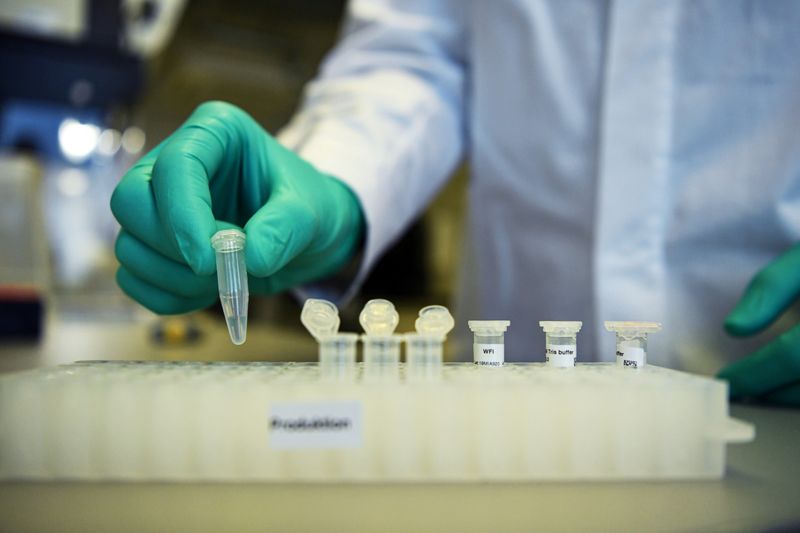(Bloomberg) --
The medical industry’s dash to produce the world’s first coronavirus vaccines in just a few months is heightening the urgency for the workhorses of global trade to be ready for the historic charge to defeat the disease.
Only 28% of companies involved in supply-chain logistics feel well prepared to handle Covid-19 vaccines and 19% characterized their readiness as very unprepared, according to a survey released Wednesday that showed a wide swath between optimists and pessimists. The poll, conducted in mid-September by the International Air Cargo Association and Pharma.Aero, is part of an effort to coordinate widespread delivery of the immunizations.
Just over half of 181 respondents already have the vehicles, containers and the connections needed to move hundreds of millions of vials in a constant deep-freeze. Almost a quarter said they’re still trying to procure such equipment, the survey of airlines, freight forwarders, airport operators and ground handlers showed.
The preparedness of those responsible for moving the medicine from manufacturing sites to health clinics worldwide is paramount because the doses, once in transit, must stay ultra-cold as they traverse a world economy where supply chains are already at capacity. The industry is also trying to avoid bidding wars, shortages and every-country-for-itself attitudes that sparked a stampede for personal protective equipment in the initial months of the pandemic.
“This is the greatest challenge that the logistics industry is facing today or maybe ever,” said Emir Pineda, manager of aviation trade and logistics at Miami International Airport and a board member of the association, known as Tiaca. “The supply chain is made up of many links and if one of those links breaks, then we’re going to have an issue.”
With little precision about when drug makers will produce enough vaccines for mass distribution, logistics estimates are hard to come by and inherently unreliable. Pineda said that the Covid-19 vaccine rollout alone may generate 65,000 tons of air freight, more than four times the amount of vaccines transported in 2019 and enough to fill 930 Boeing (NYSE:BA) Co. 747 freighters.
Different Ballgame
The drug industry has been transporting vaccines for many years without much fanfare, so the expertise exists. But the magnitude and complexity of this effort will require much more coordination between private industry, customs officials, governments and non-governmental organizations.
“Before Covid-19, it was 100% scalable: We knew how many flus there were in the world, we know how many cases of meningitis there were,” said Frank Van Gelder, secretary-general of Pharma.Aero. “But suddenly you have a pandemic, which captures the entire global population and then you start to play a different ballgame.”
Such a large airlift would be difficult in normal times. The task looks especially daunting on top of the sustained, solid demand for online merchandise and basic necessities like groceries that are already filling cargo planes and container ships. The cost of air freight is up about 50% from a year ago, and seaborne shipping-container rates have tripled since the start of the year.
Meanwhile, transport companies have starting mapping out where the bulk of the vaccines will be produced -- in places like Illinois, North Carolina and the Northeast in the U.S., the U.K., Ireland and Germany in Europe, and in Asia’s pharma hubs in India and China.
While companies like FedEx Corp (NYSE:FDX). and United Parcel Service Inc (NYSE:UPS). are investing in freezer space, there’s still concern about addressing “the last mile” of distribution, particularly in remote and often impoverished regions hard to reach with extreme refrigeration -- anywhere from -20 to -80 degrees Celsius (-4 to -12 degrees Fahrenheit) that will be required.
Along parts of the vaccines’ journey, there will be electricity available for refrigeration and battery-powered coolers. On other legs, though, the survival of the doses will depend on dry ice packed in boxes, raising a range of risks including premature thawing to safety questions for handlers because of the fumes emitted when it sublimates.
The complexity of the mission could exert strains on the logistics industry so great that it may require military might, through authorities like the U.S.’s Civil Reserve Air Fleet, a program established in 1951 after the Berlin airlift that lets the Pentagon use commercial aircraft for national-security reasons.
Cold Corridor
“It’s an iPhone 12 launch on steroids,” said Neel Jones Shah, global head of air carrier relationships at San Francisco-based freight forwarder Flexport and a Tiaca director. “I would still say that the confidence in our state of readiness is maybe a 6.5 out of 10.”
That cautious optimism may grow as more companies step in to help. Among the leaders in cold-chain refrigeration is Thermo King, part of Trane Technologies (NYSE:TT) Plc, a Dublin-based maker of industrial equipment. It’s positioning its line of units for each step of the cold corridor that the logistics industry is trying to establish.
“We’re trying to make all our capacity available,” Francesco Incalza, the head of Thermo King’s business in Europe. “When I hear, for instance, that there is not enough capacity in the supply chain to move 8 billion doses of vaccine -- if you get organized, there is capacity.”
©2020 Bloomberg L.P.
